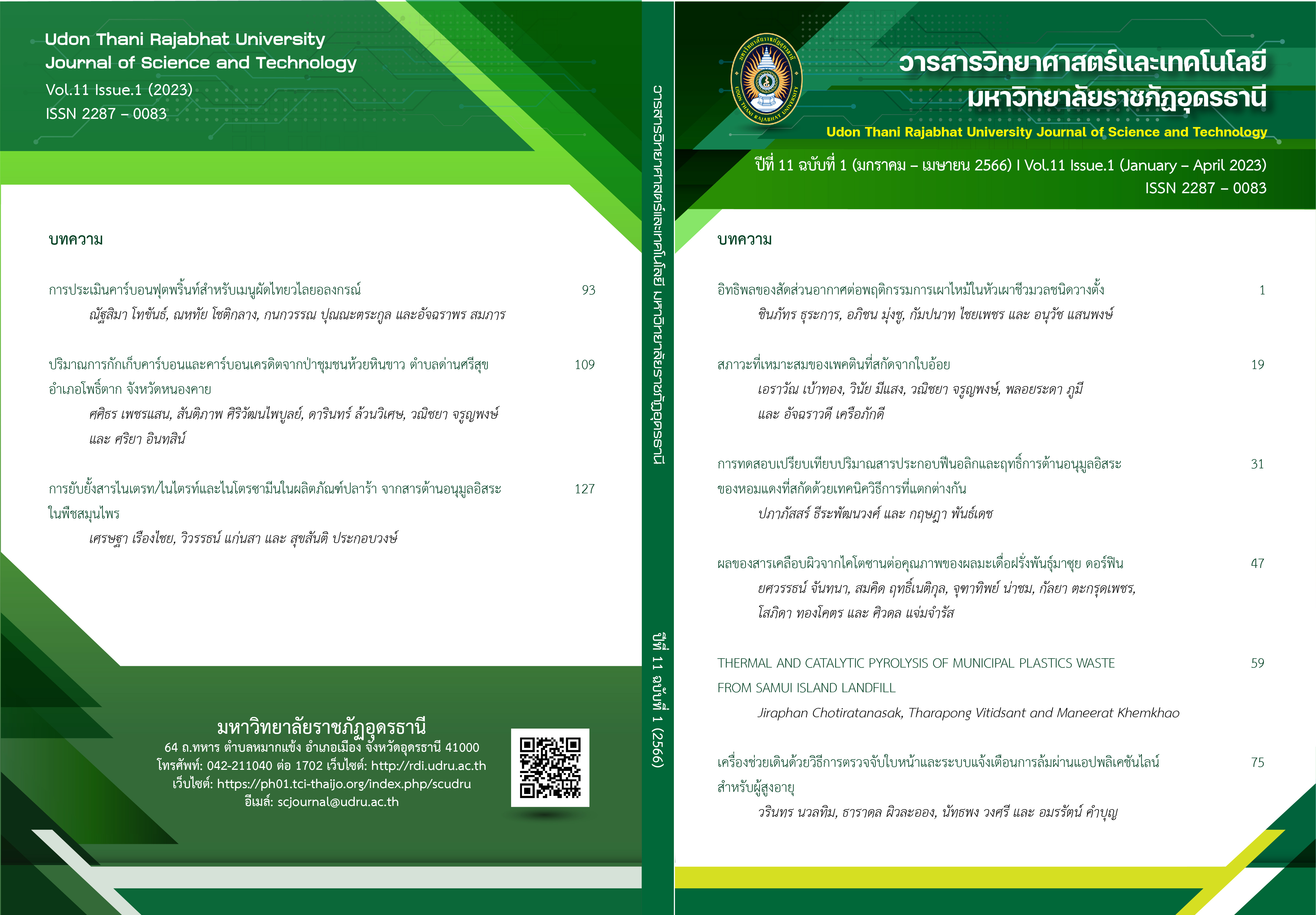สภาวะที่เหมาะสมของเพคตินที่สกัดจากใบอ้อย
Main Article Content
บทคัดย่อ
งานวิจัยชิ้นนี้มีวัตถุประสงค์ในการศึกษาสภาวะที่เหมาะสมในการสกัดเพคตินที่สกัดจากใบอ้อย โดยใช้โปรแกรม minitab ออกแบบสภาวะสกัดตามปัจจัยหลัก ได้แก่ ปัจจัยด้าน pH เวลาในการสกัดและอุณหภูมิ ได้ 15 สภาวะ คือ pH อยู่ในช่วง 2-3 เวลาที่ใช้ในการสกัด คือ 30-240 นาที และอุณหภูมิที่ใช้ในการสกัด 60-90 oC พบว่าร้อยละผลผลิตที่ดีที่สุด คือ ในสภาวะ 10 มีสภาวะในการสกัด คือ pH เท่ากับ 3.0 เวลาเท่ากับ 30 นาที และอุณหภูมิ 75 oC มีร้อยละผลผลิตเท่ากับ 22.65 และในสภาวะ ที่ 1 มีค่าร้อยละผลผลิตน้อยที่สุด สภาวะในการสกัด คือ pH เท่ากับ 2.5 เวลาเท่ากับ 135 นาที และอุณหภูมิ 75 oC มีร้อยละผลผลิตเท่ากับ 8.65 และพบว่าปัจจัยหลักที่มีผลต่อการสกัดเพคตินจากใบอ้อย คือ ปัจจัยด้าน pH และอุณหภูมิ
Article Details
เอกสารอ้างอิง
จุฑามาศ เลิศอยู่สุข, สุวรรณา ประณีตวตกุล และ ประเสริฐ ฉัตรวชิระวงษ์. (2561). การรับรู้และความพึงพอใจของเกษตรกรต่อคุณลักษณะวิธีการเก็บเกี่ยวอ้อยที่เป็นมิตรต่อสิ่ง แวดล้อมในจังหวัดเพชรบูรณ์. แก่นเกษตร, 46(2), 237-246.
เอราวัณ เบ้าทอง. (2561). แนวทางการใช้ประโยชน์เปลือกทุเรียนผสมเปลือกมะพร้าวในการสกัดเพกทิน. วารสารหน่วยวิจัยวิทยาศาสตร์ เทคโนโลยี และสิ่งแวดล้อมเพื่อการเรียนรู้, 9(2), 200-210.
Begum, R., Aziz, M. G., Uddin, M. B., & Yusof, Y. A. (2014). Chracterization of Jackfruit (Artocarpus heterophyllus) waste pectin as influenced by various extraction conditions. Agriculture and Agricultural Science Procedia, 2, 244-251.
Bichara, L. C., Alvarez, P. E., Bimb, M. V. F., Vaca, H., Gervasi, C., & Brandan, S. A. (2016). Structural and spectroscopic study of a pectin isolated from citrus peel by using FTIR and FT-Raman spectra and DFT calculations. Infrared Physics & Technology, 76, 315-327.
Blanco‑Pérez, F., Steigerwald, H., Schülke, S., Vieths, S., Toda, M., & Scheurer. S. (2021). The dietary fiber pectin: health benefits and potential for the treatment of allergies by modulation of gut microbiota. Current Allergy and Asthma Reports, 21(43), DOI: 10.1007/s11882-021-01020-z.
Dranca, F., & Oroian, M. (2018). Extraction, purification and characterization of pectin from alternative sources with potential technological applications. Food Research International, 113, 327-350.
Demirel, C., Kabutey, A., Herák, D., Sedlacek, A., Mizera, C., & Dajbych, O. (2022). Using box–behnken design coupled with response surface methodology for optimizing rapeseed oil expression parameters under heating and freezing conditions. Processes, 10, 490. https://doi.org/10.3390/pr1003 0490.
Fissore, A., Rojas, M., & Gerschenson, L. N. (2012). Rheological performance of pectin-enriched products isolated from red beet (Beta vulgaris L. var. conditiva) through alkaline and enzymatic treatments. Food Hydrocolloids, 26, 249 – 260.
Kurita, T., Fujiwara, E., & Yamazaki, E. (2008). Characterization of the Pectin Extracted from Citrus Peel in the Presence of Citric Acid. Carbohydrate Polymers, 74, 725-730.
Kyomugasho, C., Christiaens, S., Shpigelman, A., Loey, A. M. V., & Hendrickx, M. E. (2015). FT-IR spectroscopy, a reliable method for routine analysis of the degree of methylesterification of pectin in different fruit-and vegetable-based matrices. Food Chemistry, 176, 82-90.
López-Velázquez, L. Y., Salgado-García, S., Córdova-Sánchez, S., Valerio-Cárdena., C., Bolio-López, G. I., Castañeda-Ceja, R., LagunésEspinoza, L. del C., & Falconi Calderón, R. (2021). Characterization of cellulose and sugarcane (Saccharum spp.) straw from five cultivars grown in the humid tropic of Mexico. Agro Productividad, https://doi.org/10.32854/agrop.v14i9.2034.
Masmoudi, S., Besbes, M., Chaabouni, C., Robert, M., Paquot, C., Blecker, C., & Attia, H. (2008). Optimization of pectin extraction from lemon by-product with acidified date juice using response surface methodology. Carbohydrate Polymers, 74, 185–192.
Oliveira, T. I. S., Rosa, M. F., Canalcante, F. L., Pereira, P. H. F., Moates, G. K., Wellner, N., Mazzetto, S. E., Waldron, K. W., & Azerefo, H. M. C. (2016). Optimization of pectin extraction from banana peels with citric acid by using response surface methodology. Food Chemistry, 198, 113-118.
Roy, M. C., Alam, M., Saeid, A. Das, B. C., Mia, M. B., Rahman, M. A., Eun, J. B., & Ahmed, M. (2017). Extraction and characterization of pectin from pomelo peel and its impact on nutritional properties of carrot jam during storage. Journal of Food processing and Preservation., 42, 1-9.
Santos, J. D. G., Espeleta, A. F., Branco, A., & Assis, S. A. (2013). Aqueous Extraction of Pectin from Sisal Waste. Carbohydrate Polymer, 92, 1997-2001.
Sundarraj, A. A., Vasudevan, R. T., & Sriramulu, G. (2017). Optimized extraction and characterization of pectin from jackfruit (Artocarpus integer) wastes using response surface methodology. International Journal of Biological Macromolecules, 106(3), DOI: 10.1016/j.ijbiomac.2017.08.065.
Thirugnanasambandham, K., Sivakumar, V., & Maran, J. P. (2014). Process optimization and analysis of microwave assisted extraction of pectin from dragon fruit peel. Carbohydrate. Polymer, 112, 622-626.
Wai, W. W., Alkarkhi, A. F. M., & Easa, A. M. (2010). Effect of extraction conditions on yield and degree of esterification of durian rind Pectin: An experimental design. Food and Bioproduct Process, 88, 209-214.
Yang, J. S., Mu, T. H., & Ma. M. M. (2018). Extraction, structure, and emulsifying properties of pectin from potato pulp. Food Chemistry, 244, 197-205.


